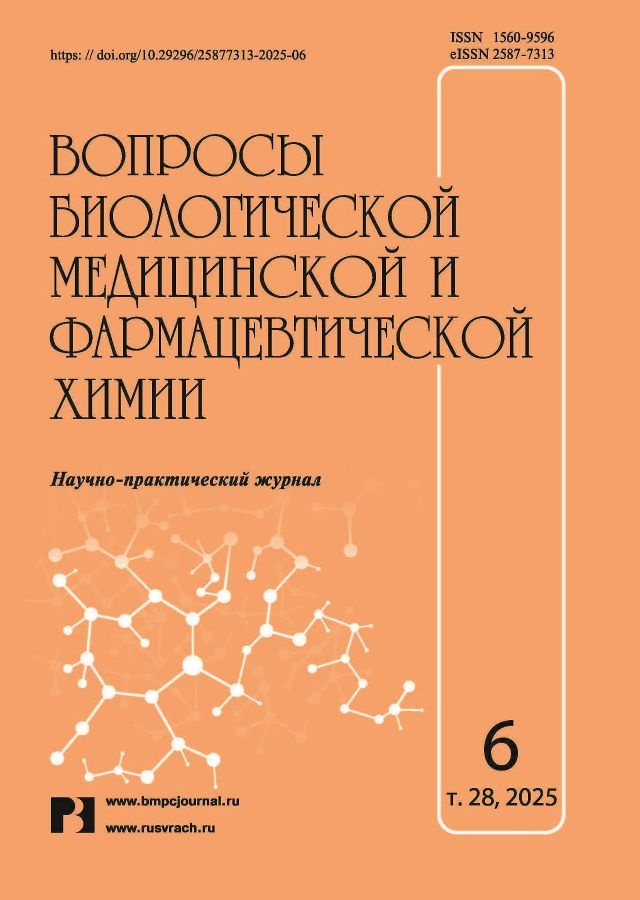Антимикробные свойства эфирного масла и водно-спиртовых извлечений из лекарственного растения пупавки благородной (Chamaemelum nobile (L.) ALL.)
- Авторы: Климович А.А.1, Игнатовец О.С.1
-
Учреждения:
- Белорусский государственный технологический университет
- Выпуск: Том 28, № 6 (2025)
- Страницы: 61-67
- Раздел: Фармацевтическая химия
- URL: https://journals.eco-vector.com/1560-9596/article/view/685631
- DOI: https://doi.org/10.29296/25877313-2025-06-08
- ID: 685631
Цитировать
Полный текст
Аннотация
Введение. На сегодняшний день одним из актуальных направлений развития фармацевтической промышленности является разработка новых препаратов на основе лекарственного растительного сырья с различным спектром фармакологического действия. Особый интерес вызывают растения, которые обладают антимикробными свойствами за счет наличия в них комплекса биологически активных веществ (БАВ). Пупавка благородная Chamaemelum nobile L. относится к перспективным источникам эфирных масел и фенольных соединений, что обуславливает необходимость изучения фармацевтического потенциала данного растения.
Цель исследования – изучение антимикробной активности водно-спиртовых извлечений и эфирного масла из растения Chamaemelum nobile L. при его культивировании в условиях центральной агроклиматической зоны Республики Беларусь.
Материал и методы. Объектом исследования являлись высушенные цветки пупавки благородной. Лекарственное сырье заготовлено в фазу массового цветения на территории Республики Беларусь в центральной агроклиматической зоне. Антимикробную активность водно-спиртовых экстрактов и эфирного масла пупавки благородной оценивали методом диффузии БАВ в агаризованную питательную среду. В качестве тест-культур использовали дрожжи и грамотрицательные и грамположительные бактерии коллекции микроорганизмов кафедры биотехнологии БГТУ: Candida albicans (АТСС 10231), Pseudomonas aeruginosa (В-126), Escherichia coli (АТСС 8739), Bacillus subtilis, Staphylococcus aureus.
Результаты. Антибактериальный эффект разной степени выраженности показали, как водно-спиртовые извлечения, так и эфирные масла из пупавки благородной. Установлено, что эфирное масло исследуемого растения проявляет более выраженную антимикробную активность в диапазоне исследуемых концентраций по отношению ко всем анализируемым тест-культурам в сравнении с эфирным маслом ромашки аптечной. Наиболее выраженные антимикробные свойства эфирного масла проявились в отношении Bacillus subtilis (МИК = 0,1±0,05) и Candida albicans (МИК = 0,07±0,02). Водно-спиртовое извлечение пупавки благородной проявляет ингибирующее действие только по отношению к грамположительным бактериям (S. Aureus, B. subtilis) при концентрации более 20 мг/мл.
Выводы. Результаты проведенных исследований позволяют рекомендовать использование водно-спиртовых извлечений, а также эфирного масла пупавки благородной в качестве компонента при разработке рецептур фитопрепаратов обладающих противомикробными свойствами.
Полный текст
Об авторах
А. А. Климович
Белорусский государственный технологический университет
Автор, ответственный за переписку.
Email: anechkaf027@gmail.com
ORCID iD: 0009-0009-4461-4841
SPIN-код: 3990-5648
аспирант, кафедра биотехнологии
Белоруссия, 220006, г. Минск, ул. Свердлова 13аО. С. Игнатовец
Белорусский государственный технологический университет
Email: anechkaf027@gmail.com
ORCID iD: 0009-0009-1376-1777
SPIN-код: 9964-1274
к.б.н., доцент, кафедра биотехнологии
Белоруссия, 220006, г. Минск, ул. Свердлова 13аСписок литературы
- Assessment report on Chamaemelum nobile (L.) All., flos. Dezső Csupor. European Medicines Agency, HMPC. 2010: 1–19.
- Адамцевич Н.Ю., Болтовский В.С., Титок В.В. Влияние параметров экстракции на выход флавоноидов из листьев воробейника лекарственного (Lithospermum officinale L.) Вести Национальной академии наук Беларуси. Серия биологических наук. 2020; 65(4): 402–411. doi: 10.29235/1029-8940-2020-65-4-402-411.
- Alvarez-Martínez F.J., Barrajon-Catalan E.J., Encinar A. et al. Antimicrobial Capacity of Plant Polyphenols against Gram-positive Bacteria: A Comprehensive Review. Curr. Med. Chem. 2020; 27(15): 2576–2606. doi: 10.2174/0929867325666181008115650.
- Acs K., Balazs V.L., Kocsis B. et al. Antibacterial activity evaluation of selected essential oils inliquid and vapor phase on respiratory tract pathogens. BMC Complementary and Alternative Medicine. 2018; 18(1): 227. doi: 10.1186/s12906-018-2291-9.
- Shin J., Na K., Shin S. et al. Biological activity of Thyme white essential oil stabilized by cellulose nanocrystals. Biomolecules. 2019; 9(12): 799. doi: 10.3390/biom9120799.
- Valdivieso-Ugarte M., Gomez-Lorente C., Plaza-Díaz J. et al. Antimicrobial, Antioxidant, and Immunomodulatory Properties of Essential Oils: A Systematic Review. Nutrients. 2019; 11(11): 2786. doi: 10.3390/nu11112786.
- Лыков И.Н. Исследование противогрибковой активности действия эфирных масел. Тенденции развития науки и образования. 2019; 51(6): 17–20. doi: 10.18411/lj-06-2019-126.
- Kumar S., Pandey A.K. Chemistry and biological activities of flavonoids: an overview. Scientific World Journal. 2013: 1–17. doi: 10.1155/2013/162750.
- Шадеркина В.А., Шадеркин И.А. Терпены и их применение в клинической практике. Экспериментальная и клиническая урология. 2019; 1: 77–81. doi: 10.29188/2222-8543-2019-11-1-77-80.
- Guimarães R., Barros L., Santos-Buelga C. et al. Nutrients, phytochemicals and bioactivity of wild Roman chamomile: a comparison between the herb and its preparations. Food Chem. 2013; 136(2): 718–725. doi: 10.1016/j.foodchem.2012.08.025.
- Al-Snafi A.E. Medical importance of anthemis nobilis (Chamaemlum nobile L.) (review). Asian Journal of Pharmaceutical Science & Technology. 2016; 6(2): 89–95.
- Климович А.А., Адамцевич Н.Ю., Игнатовец О.С. Определение оптимальных параметров экстракции флавоноидов из цветочной массы пупавки благородной (Сhamaemelum nobile (L.) All.). Вестник фармации. 2023; 101(3): 30–38. doi: 10.52540/2074-9457.2023.3.30.
- Коваленко Н.А., Леонтьев В.Н. и др. Антимикробные свойства эфирного масла растений рода Monarda, культивируемых в Беларуси. Химия растительного сырья. 2021; (2): 137–144. doi: 10.14258/jcprm.2021027638.
- Государственная фармакопея Республики Беларусь: разработана на основе Европейской Фармакопеи: в 2 т. Т. II: Контроль качества субстанций для фармацевтического использования и лекарственного растительного сырья. Центр экспертиз и испытаний в здравоохранении; ред. С.И. Марченко. 2016: 1368.
- Самылина И.А., Блинова О.А., Кумышева Л.А. и др. Перспективы создания сухих экстрактов. Фармация. 2006; 2: 43–46.
- Савельева Е.Е., Булгакова Н.А., Лапкина Е.З. и др. Антимикробная активность водно-спиртовых экстрактов представителей рода Potentilla L. Разработка и регистрация лекарственных средств. 2022; 11(4): 20–27. doi: 10.33380/2305-2066-2022-11-4-20-27.
- Рябов Н.А., Рыжов М.В., Куркин В.А. и др. Антимикробная активность водно-спиртовых извлечений листьев и почек дуба черешчатого (Quercus robur L.). Фармация и фармакология. 2021; 9(2): 104–113. doi: 10.19163/2307-9266-2021-9-2-104-113.
Дополнительные файлы









